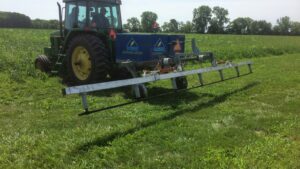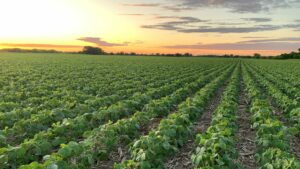Herbicide damage to neighboring crops isn’t the only thing injured. Neighborly relations suffer as a result.
In the western part of Missouri, just a 20-minute drive north of I-70, Bret and Lorin Fahrmeier branched out from the family’s traditional farm, greenhouse and winery business to start up their farm to fork venture, helping those near the Kansas City area connect with where their food comes from. This includes a U-pick patch, blackberries and strawberries in the early summer months and pumpkins in the fall. This year, the Fahrmeiers planted 18,000 strawberry plants and harvested less than half of what they did the previous year with only 10,000 plants. This, they claim is a direct result of a dicamba application made to nearby fields.
This story is all too familiar in communities across the Midwest. In 2018, more than 50 million acres were planted with dicamba-tolerant soybeans and cotton varieties, and Monsanto reports that farmers are experiencing good weed control and on-target applications. As of July 12, Monsanto reported having received 381 inquiries from 240 unique farmer and applicator calls about potential off-target movement.
But Monsanto (now Bayer) isn’t the only company to blame; there are three products, which include various dicamba formulations, on the market: Corteva AgriScience’s (originally DuPont) FeXapan, BASF’s Engenia and Monsanto’s ExtendiMax.
In the Missouri bootheel alone, Kevin Bradley estimated that 25,000 acres of soybeans had drift damage. He suspects the percentage of Xtend crops in the bootheel is probably higher than anywhere else in the country.
A report published by Bradley on June 21 highlights the alleged off-target dicamba issues. “As of June 15, university weed scientists estimate that there are approximately 383,000 acres of soybean injured by dicamba in 2018,” Bradley wrote. “A common theme again this season seems to be that fewer growers are actually turning these incidents in to the state departments of agriculture for investigation.
“Of the 15 state departments of agriculture that responded to our request for information, there were only 43 cases of alleged injury currently under investigation in soybean. However, the incidents and cases of off-target movement of dicamba to specialty crops, vegetables, ornamental species and trees seems to be more prevalent this year compared to last season as they constitute some 111 of the remaining cases under investigation.”
Bradley said from what he could tell in June, “If you don’t have Xtend soybean, your crop is going to be cupped up from one end to the other. That’s not a surprise, because that’s what we’ve seen for the past two seasons.”
Ryan Rubischko, Monsanto’s North American dicamba portfolio lead, says their team takes every inquiry seriously.
“As we’ve walked fields with growers and applicators, we’ve continued to remind them that regardless of the herbicide you’re spraying, it’s critically important to read and follow all label requirements,” Rubischko says.
He explains that in most fields inspected, they are observing multiple factors that may be the source of damage.
“It remains critically important we walk fields and examine all possible options before drawing conclusions,” he says.
But Ford Baldwin of Practical Weed Consultants does not think the same. In an open letter to the Weed Science Society of America’s Board of Directors, Baldwin says: “From the beginning, there has been plenty of published science and experience among our members to know dicamba could not be sprayed on large acreages in summer temperatures without a train wreck …
“I am an applied weed scientist in the heart of Palmer amaranth country and fully understand the need for new herbicides and technologies. I am also fully aware that dicamba will kill a pigweed that is resistant to other herbicides. However, as weed scientists, we have an environmental responsbility to be good stewards. Once again in 2018, large acreages of non-dicamba-tolerant soybeans in eastern Arkansas are affected by this herbicide as well as many vegetables. In addition, most trees in the countryside and towns are cupping and even dying following multiple years of exposure. Gardens are being destroyed and commercial vegetable producers are fearful that their crop may be condemned because of no tolerances for dicamba residues.”
In his letter, Baldwin challenges the society and its members to make sound recommendations based on the evidence and science, rather than responding to lobbyist and other monetary influences.
“I am appalled when key influencers who view from afar make flippant statements such as ‘the benefits of this technology clearly outweigh the risks’ with no environmental data to back up the statements,” he says. “Those are similar to farmer’s statements like ‘we have to kill our weeds and whatever happens as a result just happens.'”













